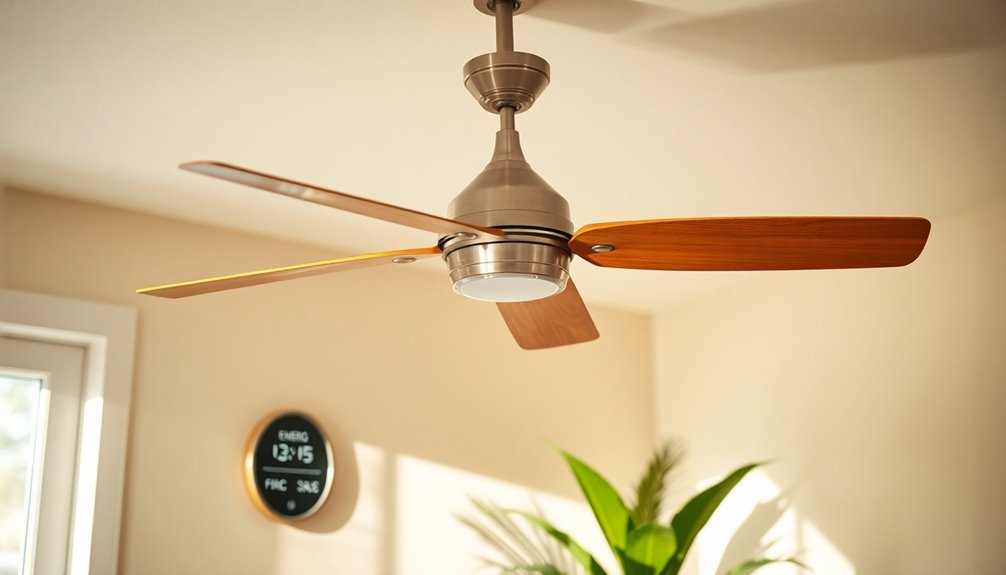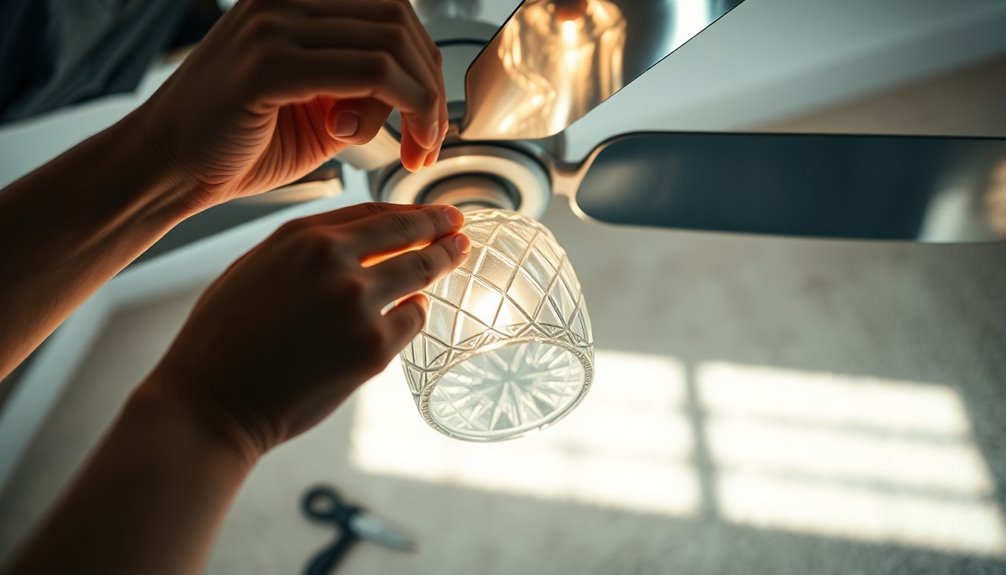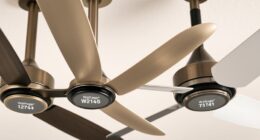Ceiling fans don't use a lot of electricity, typically consuming between 50 to 90 watts per hour. If you run a standard fan for eight hours daily, the annual cost is about $18.77. In comparison, air conditioners can use up to 3,500 watts, costing you considerably more. Energy-efficient fans can drop that usage even further, costing as little as $8 a year. This makes ceiling fans a cost-effective way to keep cool, especially when used alongside air conditioning. Want to know how you can maximize their efficiency and save even more? Stick around for more insights!
Key Takeaways
- Ceiling fans typically consume between 50 to 90 watts per hour, significantly less than air conditioners which can use up to 3,500 watts.
- Annual operating costs for ceiling fans range from $8 to $24, compared to over $81 for air conditioners.
- Energy-efficient models, like Aeratron, use only about 16.2 watts, leading to annual costs around $8.
- Using ceiling fans can reduce air conditioning reliance, allowing thermostat settings to rise and saving additional energy costs.
- Regular maintenance and optimal settings can further enhance ceiling fan efficiency, reducing electricity consumption.
Ceiling Fan Electricity Consumption

When it comes to energy efficiency, ceiling fans stand out as a smart choice for cooling your space.
You'll find that ceiling fans typically consume between 50 to 90 watts per hour, which is a fraction of what air conditioning units use—up to 3,500 watts.
For instance, running a standard ceiling fan for 8 hours daily uses about 304 watts, adding up to an annual cost of roughly $18.77 at the national average electricity rate.
If you opt for energy-efficient ceiling fans like the Aeratron model, you can bring your costs down even further.
These fans only consume around 16.2 watts per hour, translating to an annual cost of about $8.
In comparison, tower fans consume around 48 watts, costing you approximately $24 a year, while box fans range from 60 to 110 watts, leading to annual costs between $30 and $54. Additionally, using ceiling fans can reduce reliance on air conditioning, which further enhances energy savings.
Comparing Ceiling Fans and Air Conditioners

When you compare ceiling fans and air conditioners, you'll notice a huge difference in energy consumption.
Ceiling fans use just 50 to 80 watts per hour, while air conditioners can hit up to 3,500 watts.
This stark contrast not only affects your electricity bill but also your overall comfort and cooling strategy.
Energy Consumption Comparison
Comparing energy consumption between ceiling fans and air conditioners reveals a stark difference in efficiency. Ceiling fans use between 50 to 80 watts per hour, while an air conditioner uses a staggering 500 to 3,500 watts depending on the model.
When you run a ceiling fan for 8 hours daily, your electricity consumption is only about $0.05. In contrast, operating an air conditioner for the same duration can cost you roughly $1.20.
For instance, if you run a standard ceiling fan at 75 watts for 6 hours, it consumes just 0.45 kWh, whereas an air conditioner can consume up to 21 kWh under similar conditions. This significant difference in usage highlights how heat pumps can provide efficient heating and cooling alternatives.
Clearly, ceiling fans provide effective cooling options at a fraction of the energy cost. They consume only about 1% of the electricity used by air conditioning systems.
When considering annual operational costs, ceiling fans range from $8 to $24, while energy-efficient air conditioners can cost around $81.50 or more.
This highlights the significant difference in power consumption and reinforces the energy efficiency of ceiling fans as a smart choice for cooling. Additionally, the use of air purifiers can further enhance indoor air quality while maintaining low energy consumption.
Cost Efficiency Analysis
Ceiling fans not only offer a cost-effective cooling solution but also considerably contribute to savings on energy bills when compared to air conditioners.
While an air conditioner can use up to 3,500 watts per hour, a ceiling fan typically consumes just 38 to 90 watts. This stark difference in energy consumption means that running a ceiling fan for 8 hours costs you about $0.05, while the air conditioner can rack up over $1.20 for the same duration.
Annual operating costs further highlight the cost efficiency of ceiling fans. You'll spend around $18.77 per year on a ceiling fan, compared to over $81.50 for an air conditioner. Additionally, regular maintenance of your cooling systems, including heat pumps, can enhance their efficiency further, leading to more savings.
By opting for energy-efficient fans, you can reduce electricity usage by up to 60%, translating into additional savings. Additionally, using ceiling fans in conjunction with commercial grade heat pumps can further enhance your home's energy efficiency.
Moreover, if you use ceiling fans alongside your air conditioner, you can comfortably raise your thermostat settings by 4°F without sacrificing comfort.
This not only enhances your cooling experience but also considerably lowers your energy bills. Investing in Energy Star-rated ceiling fans is a smart choice for maximizing savings and efficiency in your home.
Calculating Fan Operating Costs

When you're calculating the operating costs of your ceiling fan, it's crucial to take into account both daily and annual expenses.
For instance, running a typical fan for 8 hours a day can cost you around $0.05, adding up to about $18.77 a year.
Understanding these figures helps you see just how much you save compared to other cooling options.
Daily Operating Costs
Understanding the daily operating costs of ceiling fans can help you make informed decisions about energy usage and expenses. A typical ceiling fan operates at around 38 watts and costs you approximately $0.05 per day when run for 8 hours. In contrast, energy-efficient models, like the Aeratron at 16.2 watts, can cost you only about $0.02 daily, leading to an annual cost of around $8. This highlights the potential savings you can achieve.
Here's a quick comparison of various ceiling fan operating costs:
| Ceiling Fan Type | Daily Operating Cost |
|---|---|
| Standard (38 watts) | $0.05 |
| Standard (75 watts) | $0.054 |
| Energy-Efficient | $0.02 |
| Air Conditioner (6 hrs) | $1.20 |
| Annual Cost (Standard) | $18.77 |
Annual Energy Expenses
Calculating your annual energy expenses for ceiling fans can reveal significant savings compared to other cooling options.
When you run a typical ceiling fan at high speed, it consumes about 38 watts, costing roughly $18.77 per year if used daily for 8 hours. That's a mere $0.05 a day based on the national average electricity rate of $0.169 per kWh.
In contrast, an energy-efficient fan, like the Aeratron, with a lower wattage of 16.2W, can reduce your annual operating cost to around $8. This makes ceiling fans a much cheaper choice compared to an AC unit, which can cost about $81.50 per year, even for efficient models.
If you consider other cooling devices, box fans range from $30 to $54 annually, still making ceiling fans more economical.
Plus, smart fans can optimize energy usage even further, maximizing your savings. Overall, investing in ceiling fans is a smart choice for reducing your annual energy expenses while keeping your space comfortable.
Energy Efficiency Tips for Fans

Many homeowners overlook simple ways to boost the energy efficiency of their ceiling fans. One effective strategy is to invest in Energy Star-rated models, which can save you up to 60% in energy consumption compared to conventional fans. Additionally, using air purifiers can improve indoor air quality, allowing you to feel more comfortable at higher thermostat settings. Moreover, considering wood-burning stoves as an alternative heating source can complement the use of ceiling fans by distributing heat more effectively throughout the home.
To maximize savings, remember to turn off your ceiling fan when the room isn't occupied; this helps prevent unnecessary energy usage and lower electricity bills. Regular preventive maintenance can also help ensure your ceiling fan operates at its best, similar to how proper maintenance can extend the lifespan of your appliances.
Another tip is to adjust your thermostat by 4°F when using a ceiling fan. This simple change can enhance your comfort while greatly reducing air conditioning costs.
Selecting the appropriate fan size is also vital; for example, a 52-inch ceiling fan is ideal for rooms up to 400 square feet, maximizing energy efficiency and helping to circulate air more effectively. Choosing the right fan size ensures optimal performance and comfort while complementing your space aesthetically. When searching for the best ceiling fans for living room settings, consider factors like ceiling height, blade material, and motor efficiency to enhance both functionality and style. Additionally, features like remote controls and adjustable speed settings can make your living room fan even more convenient and versatile.
Lastly, don't forget about regular maintenance. Cleaning your ceiling fan and checking its direction guarantees peak performance, which ultimately helps reduce power consumption. Additionally, choosing energy-efficient models can further enhance your overall savings.
Factors Influencing Fan Efficiency

Ceiling fan efficiency is influenced by several key factors that homeowners should consider to enhance performance and energy savings. Understanding these elements can help you make informed decisions about your ceiling fan's usage and selection.
| Factor | Impact on Efficiency | Example |
|---|---|---|
| Wattage | Higher wattage increases consumption | 52-inch fan: 90 watts |
| Speed Settings | Lower speeds reduce power usage | Low speed: 10-20 watts |
| Motor Efficiency | More efficient motors cut energy costs | Up to 60% reduction in usage |
When you choose a ceiling fan, pay attention to the wattage, as it typically ranges from 50 to 90 watts per hour. Larger fans use more power than smaller ones, so size matters! Additionally, the quality of components, like motor efficiency and blade design, greatly impacts energy efficiency. Finally, consider environmental factors like room insulation and airflow, as they contribute to ideal performance, reducing your overall consumption. By focusing on these factors, you can enjoy a more efficient and cost-effective ceiling fan experience.
Moreover, understanding energy consumption patterns can help you optimize fan usage and further decrease electricity costs.
Benefits of Using Ceiling Fans

Using ceiling fans offers a range of benefits that go beyond simple air circulation.
First, they greatly reduce electricity consumption compared to air conditioners, using only 15-90 watts versus up to 3,500 watts. This translates to an annual cost of around $18.77 for running a ceiling fan for 8 hours daily—an affordable option for most households. Additionally, ceiling fans can help maintain a comfortable indoor environment by enhancing the refrigeration cycle, which plays a crucial role in heat management. Proper airflow from ceiling fans can also complement the effectiveness of air purifiers in improving indoor air quality, especially those equipped with HEPA filter technology. Furthermore, they can significantly improve energy efficiency, akin to the benefits seen with the best heat pump systems.
You'll also find that ceiling fans enhance your comfort by allowing you to raise your thermostat settings by 4°F without feeling any discomfort. This simple adjustment can lead to even more energy savings.
Opting for energy-efficient models, like the Aeratron, is another smart choice, as they consume only 16.2 watts and cost around $8 annually.
Additionally, ceiling fans improve airflow and indoor air quality, creating a more pleasant atmosphere in your home.
By reducing reliance on air conditioning, you're also contributing to a sustainable environment. Moreover, using ceiling fans can significantly lower your overall household energy consumption, helping to decrease your carbon footprint.
Frequently Asked Questions
How Much Does It Cost to Run a Ceiling Fan 24 Hours a Day?
If you run a ceiling fan 24 hours a day, it'll cost you about $4.62 a month, which breaks down to roughly $56.40 a year.
That's based on an average electricity rate of $0.169 per kWh, with the fan consuming around 0.912 kWh daily.
This makes it a cost-effective choice for cooling compared to other options, helping you stay comfortable without breaking the bank.
Do Ceiling Fans Raise the Electric Bill?
Ceiling fans won't greatly raise your electric bill. They consume much less energy than air conditioners, typically costing you around $0.05 to $0.096 per day when used for eight hours.
In fact, using a ceiling fan can help you save money by allowing you to increase your thermostat setting without sacrificing comfort.
Is It Cheaper to Run Ceiling Fans or Air?
Imagine this: running a ceiling fan for 8 hours costs you only about $0.05.
When you compare that to an air conditioner, which could hit around $1.20 for the same duration, it's clear that ceiling fans are the cheaper option.
They not only save you money but also allow you to raise your thermostat setting, cutting down on air conditioning use.
Are Ceiling Fans Expensive to Run?
Ceiling fans aren't expensive to run at all.
In fact, they use just 38 to 75 watts per hour, which is a fraction of what air conditioners consume. You'll only spend about $0.05 daily or around $18.77 annually to keep them running.
When you compare that to the costs of air conditioning, you'll see how much you save. Plus, energy-efficient models can lower your annual costs even more!
Conclusion
To summarize, ceiling fans don't use a lot of electricity compared to air conditioners, making them a smart choice for cooling your home. You might've heard that running fans can actually save you money on energy bills—this is true! By circulating air, they can reduce your reliance on more energy-hungry cooling systems. So, next time you're sweltering in the heat, remember that a ceiling fan can be your budget-friendly ally in staying cool.









